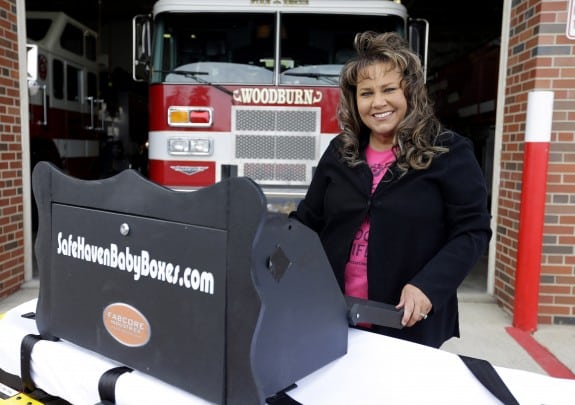The same state that recently pushed forward a bill to ban abortions is now thinking about making baby drop-off boxes widely available. These boxes would give mothers a place to anonymously give up their babies without fear of judgment of persecution, and without having to worry about being seen or talked to.
It’s unknown how many of these boxes currently exist in the United States—Banner Health offers one at their Thunderbird Medical Center—but these drop-off boxes are extremely common in Europe and Asia.
They also receive quite a bit of criticism from those that feel the core issues of child abandonment aren’t being addressed by the boxes. In fact, Elizabeth Throssell, a spokeswoman for the United Nations Committee on the Rights of a Child, says that, rather than fund the cost of the boxes, countries should instead provide family planning options and other types of support to address common reasons for child abandonment, such as poverty.
Another concern about the boxes is that the mother may need medical care, and rather than receive it, she’ll simply drop off her baby, potentially leaving herself at severe risk. With Safe Haven locations where there is no drop-off box, she would be assessed and at least seen to determine if medical care is needed. This also gives trained professionals the chance to determine why she might be choosing to hand her baby over, opening up a door to possibly providing assistance if she simply needs financial support, or other help that can be provided.
Casey Cox, who authored the bill that could potentially make around 100 baby boxes available in Indiana, says that such devices are a natural progression of the “Safe Haven” laws, which give parents the opportunity to surrender their newborns at facilities like hospitals, police stations, and fire stations. So long as the child has not been harmed in any way, these parents don’t have to worry about facing any criminal charges for surrendering the child.
But there are some other concerns about the baby boxes, namely the fact that, in Asia, where they are extremely common—so much so that they have even become the subject of a documentary—use has had to be restricted (and some have been shut down completely) because the local authorities have become so overwhelmed with the sheer number of abandonments over the years.
What’s your take on the baby boxes? We’d love to hear your thoughts!
Related Articles:








Baby Boxes Don’t Work & Are Dangerous for Mom and Baby
My name is Dawn Geras, and I am president of the Illinois Save Abandoned Babies Foundation. I am also one of the founding board members of the National Safe Haven Alliance in Washington D.C. Over the years I have assisted many states and organizations with passing and improving their safe haven laws. Please understand that I am passionate about wanting to do all that I can to save each and every baby from illegal abandonment and at first blush coming out against Baby Boxes may not seem to make sense.
After you think through this idea, I believe that you will agree and help to stop this idea. Instead let’s work together to create awareness to reach the women that need to learn that the Baby Safe Haven laws exist: Signs at Safe Havens, teaching about the law in Health Education classes, publishing the 800 crisis number, web sites, and many other proven measures that actually work.
Monica Kelsey, a paramedic with the Fort Wayne, fire department is working to add Baby Boxes to the Indiana Safe Haven program. While this may be well intended it misguided. It opens Pandora’s Box and will have unintended consequences. I am in strong opposition to the idea of placing the boxes in hospitals, police and fire stations, churches and other nonprofit organizations. Some of those reasons are:
1) Baby Boxes remove the chance for a mother to be offered medical care and supportive services. About 25% of parents who come to a Safe Haven, initially planning to use the Safe Haven Law, when given the opportunity to talk about options, chose to either made an adoption or parenting plan.
2) Baby Boxes strip away any chance of personal contact with a person, which means the parent is completely alone, contributing to her being frightened. She does not have the comfort of actually placing her baby into the arms of anyone. Instead, the idea that what she is doing is ‘bad’ and something that she should feel ashamed about is reinforced
3) Baby Boxes will add tremendous confusion as to where and what is considered a Safe Haven location. There are so many bad possible out comes to this. For example, a mother comes to a hospital, looking for a Baby Box, but that hospital doesn’t have one. She becomes frustrated, confused, and leaves the baby alone, abandoned. Will the baby survive? The mother is bleeding, in need of medical help that she does not get. How will people feel when she is found having bled to death?
4) Many women are looking for a safe delivery of their baby in the hospital. Baby Boxes will confuse hopes for a safe delivery by suggesting that her only option is to leave the baby in a Baby Box.
5) Many States offer a packet of information for the relinquishing parent. The packet may provide medical information, explain their rights under the law, and a form for medical information. Using Baby Boxes prevents the parents from receiving this important information.
6) Expanding the boxes to include churches and other nonprofits increases the dangers exponentially.
7) And, of course, the cost! I’ve heard that each box will cost approximately $5,000 to build with a plan to have 100 installed by next summer. Half a million dollars! What about the cost of installation? Most hospital, fire and police stations are brick or stone buildings, and the installation of would be near impossible. These buildings are built as the strongest structures in the neighborhoods. It would be extremely costly to cut a hole into one of these buildings to place a Baby Box in a prominent place that could be easily found by a woman in crisis. Does Indiana have the money to allocate for this project?
Think about what that money could do if used for an awareness campaign instead. How many more babies and mothers would be saved by reaching all women? Then comes the question of where the funding will come from. What is this source of the Private Funding is being referred to? Would an adoption agency put up a Baby Box so they’d have more babies for their parents who want to adopt a baby?
Do you recall when Nebraska didn’t carefully weigh the problems with the first Baby Safe Haven legislation they passed, and the unintended consequences that resulted? They called an emergency session to amend the law. You have a chance to not make a similar, inadvertent mistake.
Safe haven programs have saved over 2,866 infants since its conception in 1999. The numbers are increasing each year as more people learn about the law. What is needed are awareness campaigns NOT Baby Boxes.
Questions:
1) There are some 161 hospitals in Indiana. Who decides which hospital get boxes installed? What is the Hospital Association position on this? Will hospital pay for the installation and cost of staffing the boxes?
2) What about the issue of “separation of church and state” since these are to be installed in Churches? What exactly is a ‘Church’? Does that means only Christian facilities and not Temples, Synagogues, Mosques? Who makes this determination?
3) Who are the people planning to manufacture and profit from manufacturing the boxes?